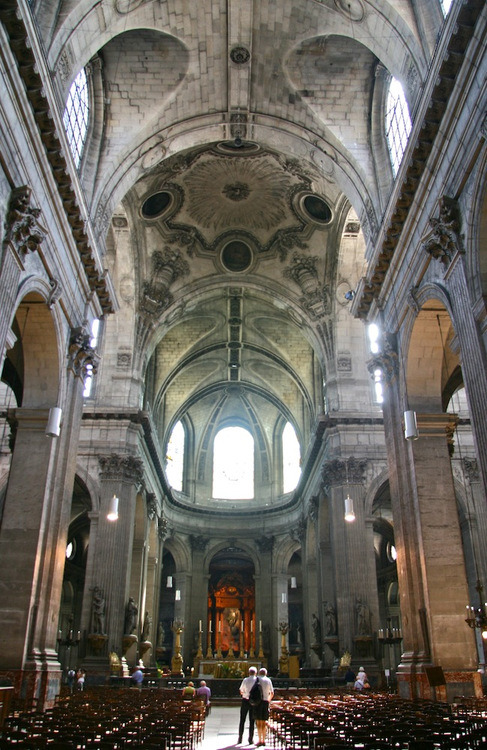Saint-Sulpice is a Roman Catholic church in Paris, France, on the east side of the Place Saint-Sulpice within the rue Bonaparte, in the Luxembourg Quarter of the VIe arrondissement. At 113 metres long, 58 metres in width and 34 metres tall, it is only slightly smaller than Notre-Dame and thus the second largest church in the city. It is dedicated to Sulpitius the Pious. During the 18th century, an elaborate gnomon, the Gnomon of Saint-Sulpice, was constructed in the church.
The church has a long-standing tradition of talented organists that dates back to the eighteenth century (see below). In 1862, Aristide Cavaillé-Coll reconstructed and improved the existing organ built by François-Henri Clicquot. The case was designed by Jean-François-Thérèse Chalgrin and built by Monsieur Joudot.
Though using many materials from Clicquot's French Classical organ, it is considered to be Cavaillé-Coll's magnum opus, featuring 102 speaking stops, and is perhaps the most impressive instrument of the romantic French symphonic-organ era.
Its organists have also been renowned, starting with Nicolas Séjan in the 18th century, and continuing with Charles-Marie Widor (organist 1870-1933) and Marcel Dupré (organist 1934-1971), both great organists and composers of organ music. Thus for over a century (1870–1971), Saint-Sulpice employed only two organists, and much credit is due to these two individuals for preserving the instrument and protecting it from the ravages of changes in taste and fashion which resulted in the destruction of many of Cavaillé-Coll's other masterpieces. The current organists are titulaire Daniel Roth (since 1985) and assistant titulaire Sophie-Véronique Cauchefer-Choplin.
This impressive instrument is perhaps the summit of Cavaillé-Coll's craftmanship and genius. The sound and musical effects achieved in this instrument are almost unparalleled. Widor's compositional efforts for the organ were intended to produce orchestral and symphonic timbres, reaching the limits of the instrument's range. Albert Schweitzer, his student and collaborator—despite initiating an "Orgelbewegung," or organ reform movement, which deplored many nineteenth-century developments—called this organ the most beautiful in the world. More recently, Stephen Bicknell concurred, pointing out that the full ensemble of many large organs is dominated by a few powerful stops; but at S. Sulpice many ranks, each of moderate power, contribute to a sound of dazzling complexity. With five manuals— keyboards— and boasting two 32-foot stops, organists at St. Sulpice have an incredibly rich palette of sounds at their disposal.
Aside from a re-arrangement of the manual keyboards c. 1900, the installation of an electric blower and the addition of two Pedal stops upon Widor's retirement in 1934 (Principal 16' and Principal 8' donated by Societe Cavaille-Coll), the organ is maintained today almost exactly as Cavaillé-Coll left it.
In Saint-Sulpice Sunday organ recitals are held on a regular basis (Auditions du Dimanche, following the High Mass, usually from 11:30 till 12:05 clock, during the subsequent mass, a visit of the organ loft possible). In 2006, to celebrate the 25th anniversary of his concert debut, the organist, Xaver Varnus played a sold-out concert on the Cavaillé-Coll organ in Saint-Sulpice.
Source:
Picture:Link:
Wikipedia:Link:

0 comments:
Post a Comment